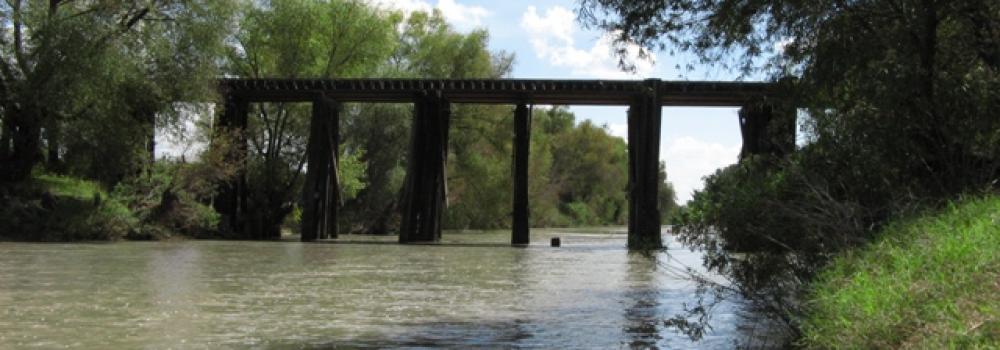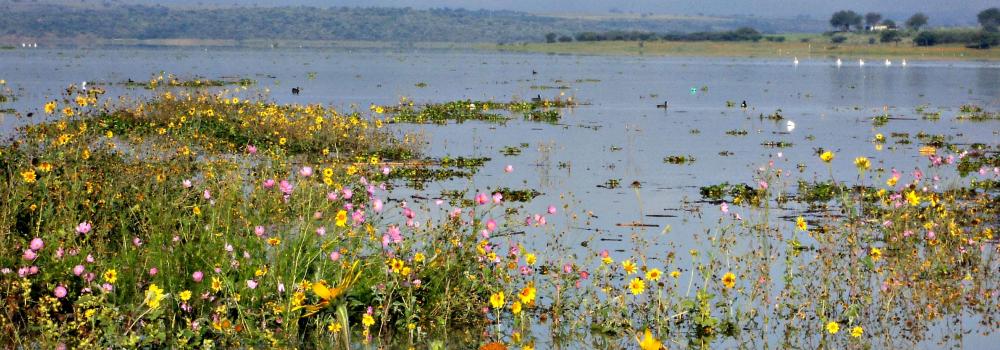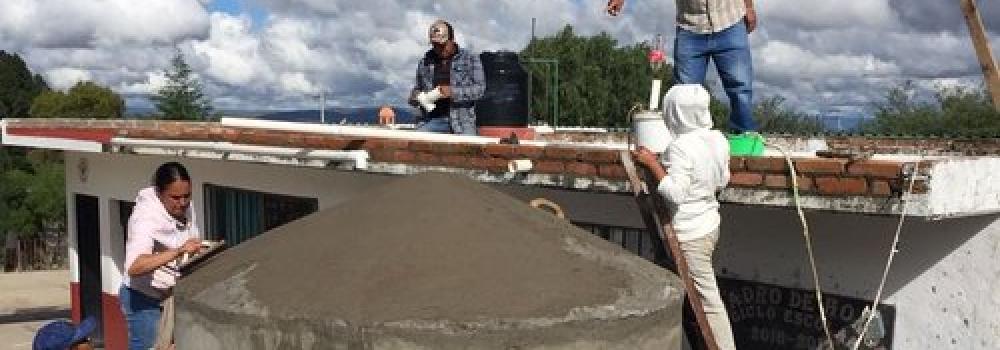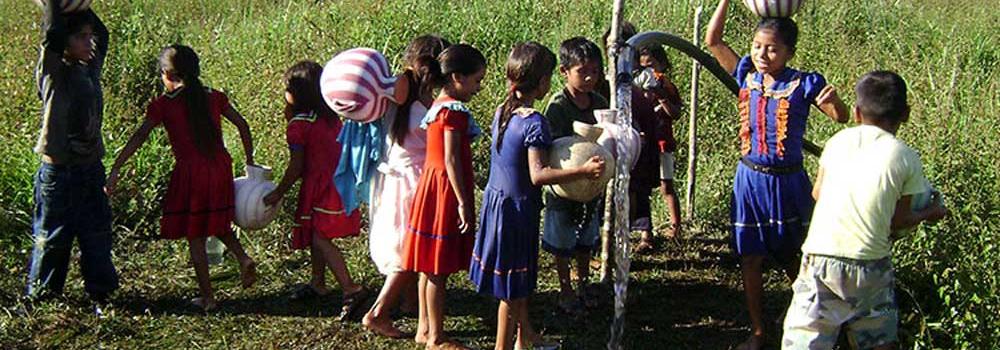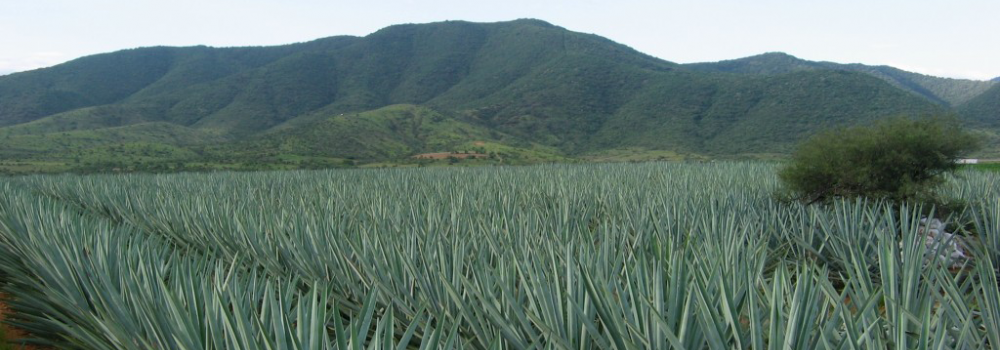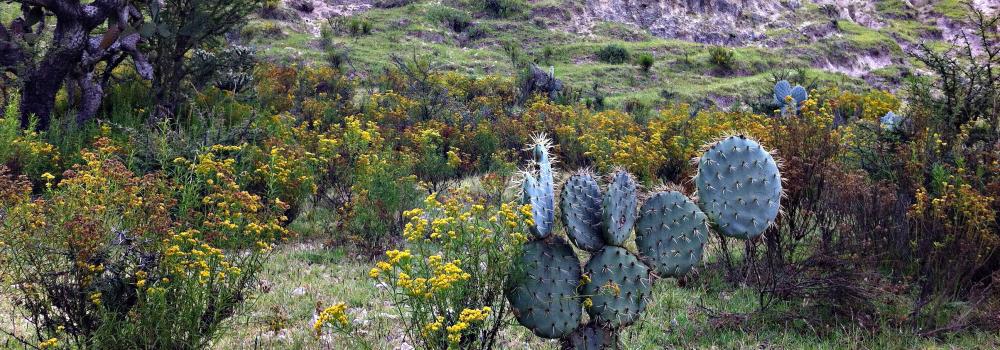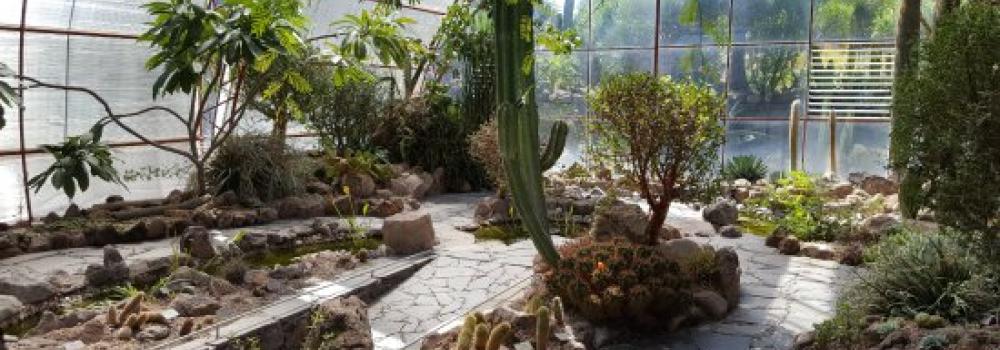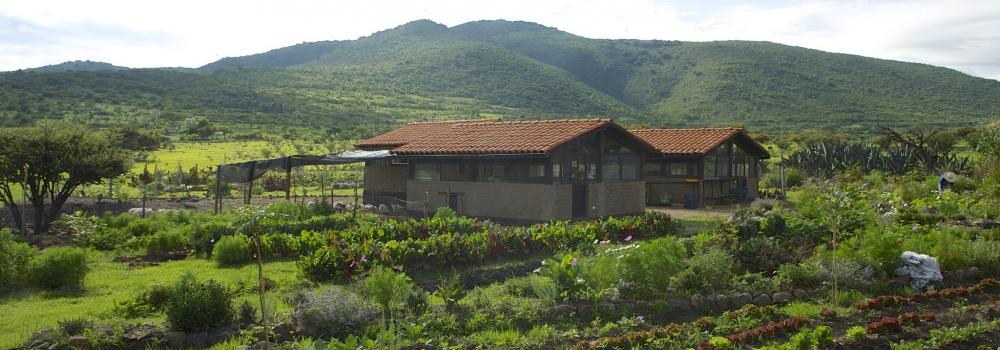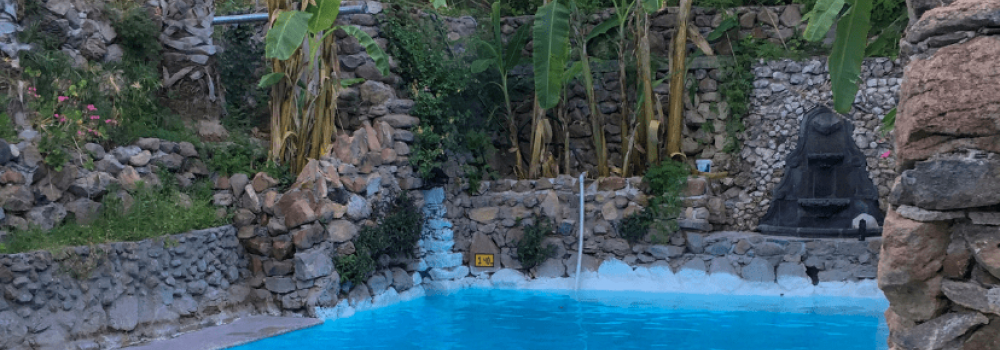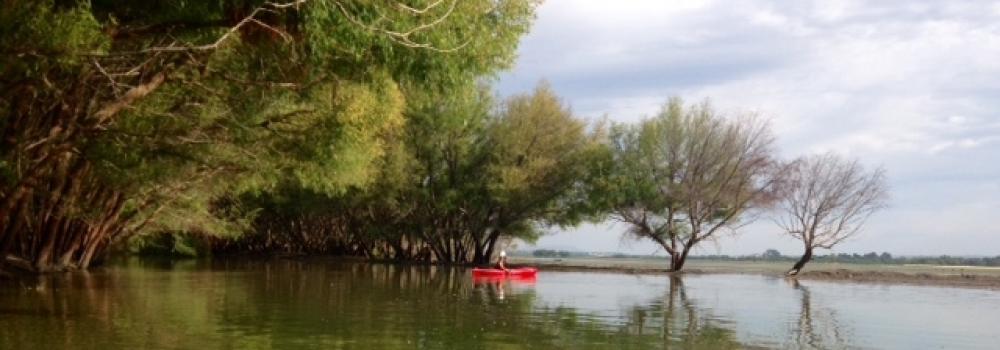The Realito Dam is located on the Santa Maria River in San Luis de la Paz, Guanajuato. Officially inaugurated on October 9th, 2012, the primary objective for its construction is to provide drinking water to the 1.7 million residents of Celaya, San Miguel de Allende and San Luis Potosi, guaranteeing 30 years of safe and accessible water. The State Government has initiated the construction of a 172 kilometers long pipeline in order to provide water throughout the region. According to official sources, this will save a third of the San Luis Valley aquifer and ecrease the rate of extraction.
In this sixth edition of The Water Dialogues ‘The Realito Dam and Public Policies’ our panel will address many questions left unanswered concerning the effectiveness of the Realito Dam and its plans to resolve the exploitation of the Independence Aquifer. Their responses will provide clarity concerning the residential, agricultural and commercial uses and costs, particularly within a region experiencing rapid business development.
Some of the questions are: How will these dam impact water rates? Could it provoke substantial changes in people´s attitudes regarding the demand and consumption habits? What will the residential and industrial affects be?
Representing CONAGUA, the National Water Commission, Luis Enrique Aguilera Ortega, a civil engineer from the University of Guanajuato with a master’s degree in soil mechanics, has participated in the design of the new copper concentrator for Cananea and offshore studies in the area of Campeche. He currently directs several studies and projects for the coverage of drinking water, sewerage and sanitation in the area of Guanajuato.
Representing CEAG, the Guanajuato State Water Commission, is engineer José Luis Cruz, a geologist who graduated from the National Polytechnic Institute and is Director of Research and Monitoring of the CEAG . He has developed several hydrological studies for the state of Guanajuato and has expertise in Integrated Watershed Management.
On this panel we also have participating Ricardo Sandoval, a civil engineer and private and international consultant for the UN, UNAM, the IDB, the World Bank, the German Agency for International Cooperation (GIZ), the German Bank KfW, the French Development Agency (AFD) and the International Cooperation Administration of CONAGUA.
Mr. Cesar Arias, President of San Miguel’s El Charco del Ingenio, a human rights and environmental activist of San Miguel and Guanajuato will be our moderator.
Cesar Arias: We are pleased because these Water Dialogues continue to address issues that have to do with this critical resource which must be considered a human right, not a commodity. The Realito Dam has puzzled many of us because, as in the past, it´s the result of the government´s decision and federal power without previous consultation with the citizens and experts who operate in this region. We have in this panel three people with profound knowledge of our water resources and it´s an extraordinary opportunity to express our doubts, especially because there has not been enough information on this topic that affects us deeply.
Ricardo Sandoval gave the green light to develop the treatment plant of the Landeta Park when he led the Water State Commission. Unfortunately this plant has not had a happy ending. Undoubtedly, Ricardo Sandoval has a very deep and independent knowledge and that is an enormous value that we should take advantage of.
Ing. Ricardo Sandoval: I was in charge of the Water State Commission in 2006. Before that I moved to Guanajuato in l998. After 2006 my relation to the Guanajuato water projects has been practically null. But I want to tell you a little about the origin of this idea of using the Panuco Basin.
The new federal government is reassessing the recent use of that basin as well as many of the large public works in the country, and I do not know what the status of the Realito Dam is In l998 I moved to Guanajuato to be in charge of the Planning Office, first designing the State Water Program. In Mexico, the water management, monitoring and allocation is a Federal responsibility through the National Water Commission. But the potable water and sanitation services orrespond to the municipal governments.
The state government does not have a specific function in the management or provision of services, only by request of the municipalities. In some neighboring states, such as Querétaro, the state government is responsible for the services through the State Water Commission. That´s not the case in Guanajuato. The CEAG (Comisión Estatal del Agua) on the one hand supports the efforts of the CNA (Comisión Nacional del Agua) with metering and organizing the users, and on the other hand, supports the municipalities with budget as well as with legal and technical support and often represents them within the Watershed Council (Consejo de Cuencas).
In 1996 Vicente Fox decided that the state of Guanajuato would have its own water strategy. In this part of the Lerma Chapala, as in the center and south of the state, there is no water available. Groundwater, in the Bajio area, which was nearly at the surface 60 years ago is now 100 and 120 meters deep. Heavy metals are present and affecting the water quality in cities such .
In the case of surface water, such as Lake Chapala, which is located at the furthest point of its watershed, is also at its lowest level because it is a very shallow lake. If we made a model it would be 2 meters by 7 meters and less Guanajuato is very stressed with practically no surface water.
The city of Leon still depends on a highly overexploited aquifer so the state government has tried to promote efficient water use and the organization of the groundwater consumption through the COTAS (Consejo Técnico de Aguas They agreed to do studies of the behavior of the aquifers and to organize the users to learn the mechanisms of self-control.
The other agreement was to support the National Water Commission in regulating the water concessions because it requires permission to draw water from the aquifer. And another very important agreement was to invest in treated water for agriculture.
Realistically, the horizon that could stop this exploitation was not immediate. The difference between the aquifer of Queretaro, which has between 160 and 200 users with legal concessions and the Bajío aquifers, with up to 4000
users, made us face a very complex problem.
At that time we had to ask ourselves where to get the water. At the same time, the State Institute of Ecology started with watershed management and the COTAS as well. The demand would grow to the extent that we would not reach the volume we needed. At that time it was decided that for the case of Leon, as determined in the ‘80s, the next source would be the Verde River in With Governor Fox it was decided that for the rest of the state, the only place available was the Panuco River. We are talking about the far north / eastern part of the state. The places in Mexico where dams have not been built it is because they were even more expensive, inaccessible and risky. Then in 1998 we started new studies. The first site to build a dam was on the Santa Maria River, a tributary of the Panuco River. We also carried out a feasibility study with Queretaro and San Luis Potosi, a basin that we share.
The first studies in El Capulin were negative, until we started building The Realito Dam which was finished last year. The dam was built in four years, very fast. An agreement was signed with San Luis Potosí so that each state could extract one cubic meter per second. I have to admit that the metering in that basin was not very good. San Luis Potosi fought for its cubic meter and is already building the aqueduct, as well as a series of projects to improve water use and conservation in the city. It was also planned that it would be necessary to build another aqueduct to Celaya.
As far as I know in 2005-2006, there was a very detailed evaluation of the whole project because it is very expensive to pump so much water. At some point I explained to Governor Romero and to the Secretary of Economic Development the need to find a mechanism to sell water to industry; otherwise it would not be economically viable. I do not know if there is another approach to this issue.
The project would benefit San Miguel and Celaya because it means extracting less ground water. But we would have to analyze the impact because, unlike Querétaro (which is the main user of this aquifer, along with Leon ) the majority of water in Celaya is for agricultural use.
If the intention is to stop the overexploitation of the aquifer, we must control the extraction of water for agriculture. But that is a long-term project. That is not an excuse, but I was able to see Arizona ‘s plans and they have a 20 to 25 year project to control the overexploitation of Tucson´s aquifer.
These are very complex programs because, in order to bring water from the Realito Dam, we first have to see if it is technically feasible, even though engineering can do almost anything. However, it must also be economically viable and we have to make operational adjustments. It´s not the same thing to distribute water from the wells situated throughout the urban area as to distribute it from a single source. This would require new storage and distribution mechanisms.
I understand that in San Miguel there is a modernization project to improve the network, whether you bring water from The Realito Dam or not. This is necessary in order to improve the distribution and at a certain point to incorporate water from a single source.
Cesar Arias: I would like to know why a water supply project of this nature was launched before rethinking agricultural consumption practices, as is the case of Celaya, which is not the same as that of San Miguel or San Luis Potosí. If The Realito Dam is going to be used for agricultural purposes, there are patterns of consumption that are terribly predatory, especially in export agriculture, such as broccoli , literally ” little bags ” through which water is exported.
Is The Realito Dam going to foster a predatory model which obviously has not been questioned in the state of Guanajuato?
Mr. Jose Luis Cruz / CEAG: Before addressing the questions, I will add to the notes about the conditions already mentioned by Ricardo Sandoval. Guanajuato is deficient in both groundwater and surface water. No water is available in what we call the Lerma- Chapala Basin covering 77 percent of the state´s territory, which has 36 thousand square kilometers. The only area where there is surface water availability is in the northeastern part, the watershed of Santa Maria.
The state government, through the CEAG, began doing feasibility studies in 1998. At that time the idea was to supply water to SMA and the municipalities of Comonfort, San Diego de la Union, San Luis de la Paz, Doctor Mora and San José Iturbide.
In the watershed of Santa Maria a hydrologically important site of 5 cubic meters per second was found. However, geology studies did not continue because it was found very big limestone caves in the area would create a problem for storing water.
Further studies were coordinated upstream from that site, trying to find a more appropriate one, and finally The Realito was located where the dam could be embedded in the volcanic rock. However, the available water volume was reduced to 2 cubic meters per second. So the decision was made to supply only SMA and Celaya, instead of covering the other municipalities.
The San Luis Potosí government expressed the need in 2007 to participate in the project and the construction of the dam began in 2008 with money from the Federal Government. They relied on the 1998 studies and with that information the project was concluded last year. Today it has stored 51 percent of its capacity in the rainy season.
San Luis Potosi built the dam and is building the aqueduct to San Luis Potosí that is 80 percent completed. It is 32 kilometers long and has to gain 1,050 meters of elevation, so it requires 3 pumping stations. The water flows by gravity in freefall to a water treatment plant and then goes to SLP.
In order to direct the water to Guanajuato we need a 4th pumping station to gain a height of 1,200 meters. That is how the project is conceptually defined. However, considering the length, the altitude, the infrastructure investment and maintenance, as well as the operation expenses, a detailed financial analysis shows that the cost per cubic meter of water is quite expensive. So according to these studies the project is not viable for the cost is around 8.80 pesos per cubic meter, including pumping, electric power, infrastructure, sanitation, maintenance and operation costs.
Therefore, this is not the best time to address the construction of the project to Guanajuato, San Miguel or Celaya and yet the state takes continues the project considering it as a planning measure. We now have the concept but the construction of the project is not to be realized at the present moment.
César Arias: Thanks for the technical information, although questions about the extraction model remains to be reviewed. We are concerned about this model which will continue to draw water for export through agricultural products. I´m aware these are broad themes and are difficult to answer.
Mr. Luis Enrique Aguilera Ortega / CONAGUA: I will give some background before addressing the questions. Drinking water management in Mexico had a major shift in l990. Until that time the federal government was responsible for doing all the works for both drinking water and agricultural irrigation. At that time there was a change in public policies and the National Water Commission was created. Since then the municipalities have been able to construct their own infrastructure. That’s important because CONAGUA creates programs and provides federal resources working with state and local counterparts in order to do the necessary construction of public works projects throughout the country.
The central point of this policy was to consolidate state and municipal agencies such as SAPASMA—state and municipal. This policy continues as well as the programs with important financial resources from the federal government, the states and municipalities. Additional programs were created within these policies when a project exceeds the programmed costs. Such is the case of The Realito Dam, The Zapotillo Dam, treatment plants as large as the one in Celaya and
improvement projects for the operating agencies. Ultimately, the money that the municipalities exercise with the participation of the federal government is for the agency to supply drinking water, have a good sewage system and wastewater treatment. The state of Guanajuato improved from 2 or 3 treatment plants in the year 2002, to 36 treatment plants.
These big projects like The Realito arise when there is no water in a certain region. So six years ago this project was started through the intervention of San Luis Potosi, a state that has industrial and economic importance, among other things. It had a more precarious situation than Guanajuato due to development and population growth.
Guanajuato is still under consideration due to the socio-economic studies, but these big programs are paid for with water rates. How will people pay these increased rates if there isn’t a good water system? SMA is being modernized with sectorization, ( division into different sections so it´s easier to control the leaks) programs and engineering work in order to save volumes of water to the extent that is required.
I believe that it is not possible to send more water to cities that are losing great amounts through leaks. Before you build the next big project, you have to recover all the huge volume of wasted water lost to leaks. If the network is losing such a high percentage of its water, why would I make an investment to keep losing water? However, the clock is ticking and populations have to be provided with water because of the economic growth.
Therefore, this is not a project to carry out next year. There are many things to consider before that happens. We are working with the operating agencies of the state government, SMA and Celaya. The water coming from The Realito Dam is quite expensive and the socioeconomic study will tell whether or not the population will be able to afford it. As far as I know, the government has not made a decision yet.
Question from the audience: I´m Isela Torres from the UTQ and I want to know why Querétaro´s strategy is different from Guanajuato?
Ing.Ricardo Sandoval: I would say the circumstances are different. From the 90´s on, water level of their acquifer was dropping fast. It was a critical situation and the idea was to bring water from the Rio Panuco and Extoraz River because there was no other choice. By suspending 80 percent of the water extraction, recovery was possible because of the type of aquifer in question.
In Guanajuato the agricultural use of water is very important. Even suspending the water extraction for urban use, you have to control the agricultural use in order for the aquifer to stabilize. The city of Querétaro has one of the largest economic growth rates in the country. And one of the highest incomes per capita. They already had 17 years sectorizing their networks and a very successful program of leak control Guanajuato has all the necessary technical studies of groundwater as well as mathematical modeling, monitoring networks and other strategies, even more advanced than in many parts of the world. But the administrative organization of the resource is where we need a lot of work to do. The state has invested heavily in the agricultural sector for their efficient use. Those with smaller plots have received more subsidies and we invested about 10 million dollars annually in the COTAS. They were given vehicles, salaries for technical experts, among other things.
Thanks to all of this we have observed a decrease in the overexploitation of the aquifers. But probably not enough. Personally I think it takes a strong shift in the way we are managing the groundwater in Mexico. The question for SMA is very simple: if you do not bring water from The Realito Dam, what´s the alternative? How efficient is the operating system?
There is a Citizen´s Observatory for Water and Sanitation in San Miguel and it is interesting for the operating system itself. Public officials can´t do magic. How are you going to support the operator in correcting waste in the networks, for example?
Question from the audience: I’m Arturo Morales and I have five very specific questions: How are all these great projects inserted within the ecological cycles of the basin and watersheds? It is interesting that the state is looking for solutions to bring water to the region, but at the same time there is deforestation and the erosion continues . Why are these projects so atomized? I congratulate you all because you are doing your job, but it seems incredible that we have not looked at the whole cycle including the the plan for land use.
The second question has to do with monitoring. How can we, as citizens, help by having access to the indicators and measurments that should be available to be read by everyone? How do I know if I’m in the red, yellow or green
The third question is: How can we as a Citizens’ Observatory of Water and Sanitation influence the decision-making for agriculture and automobile industries? How many liters or cubic meters of water does it take to produce a car? It seems that the economic cycles are separate from the ecosystems. It would have been the extreme absurdity if we had received the authorization to build the refinery exactly where the water is. But the car industry is the same, and the Honda factory is in Celaya.
Four: For this aquifer management maybe we´ll have to go one day to the House of Representatives to change the laws. But for the urgent everyday reality the Citizen’s Observatory for Water has brought scientists from prestigious universities such as UNAM to provide information on the inputs and outputs of ecological-economic systems that is what matters within a global vision. How can this information influence the public policies, directors
Fifth: we have a study that says there is only one aquifer covering seven municipalities in the north which is the area of the The Realito Dam. On the other hand, it is managed separately as administrative aquifers. I think it is urgent to bring order not only to the legislation but in fact. That not only involves the agencies. The Mayor in turn, whose opacity prevents us from knowing if the financial resources are actually being used in these improvements to the sewage system or he is taking the resources from the operating agency (SAPASMA) to use in other areas? Do not be so naive as to give all your support and trust to these agencies. There must be immediate state and federal controls and not wait six years to review the previous administration when it´s too late. There is no transparency on how funds are used, and we do not know if the leaks have declined in the system, for example.
Ing. José Luis Cruz: In the 80s the term “aquifer” was almost unknown. The wells were drilled, they were equipped and the distribution lines installed. There was no monitoring of the system and we did not have data for future planning. We didn´t know where the water came from, where it was going, how much was extracted, for whom and for what.
After the change in paradigm we started to talk about planning. The State Water Commission can only manage the public use of the water. But with the information that we gathered at that time, we realized that agriculture is the
largest consumer. However, the former State Water Law did not include agricultural aspects. Today we have the Territorial Code and the State Water Law disappeared. This change in paradigm allowed the hydrological studies,
and networks were established for isometric, climatological and water quality monitoring. We are well advanced in this.
Along with this information we have developed social participation through the COTAS and water culture programs. The irrigation systems of the Ministry of Agricultural Development have been modernized, among other things.
The isometric monitoring today tells us that the groundwater deficit is 944 million cubic meters. In 1999 we spoke of one 1200 million cubic meters. This paradigm shift has helped the stabilization of the aquifers. But not enough, yet, so we should focus more on the institutional coordination. That´s what I think we haven´t been able to achieve. Great work has been done but we You can go to the COTAS to know the results of the monitoring. We can share the information we have from the aquifers. And you all can contribute so this institutional coordination is achieved.
Mr. Luis Enrique Aguilera: When I said that 1990 had been a turning point in water management issues, I meant the water agencies should have a citizens’ advisory council. In those years there were new regulations and citizens began participating. The only solution I see to transparency is monitoring the government affairs through an organized society. You have to advocate for a change in policies.
The regulations of the water agencies should be directed to that point. There was an initial participation of citizens, businessmen, schools and other sectors, but politics began to infiltrate.
Question from the audience: I’m Enrique Orvañanos and I have more specific questions. How high is the Realito Dam from the sea level? What is its capacity in cubic meters? When they talk about 2 cubic meters per second I would like to understand the equation that is handled. I would like to know about the total investment. What percentage corresponds to the dam itself and what percentage to management and operation?
José Luis Cruz: The dam is 1,050 meters above the sea level. Its storage capacity is 50 million cubic meters to obtain 2 cubic meters per second. The dam costs 900 million pesos spent by the federal government. The aqueduct cost is 2 billion 800 pesos.
Mr. Luis Enrique Aguilera: As a benchmark, the Allende Dam can contain 150 million cubic meters at its normal level and 250 million in its extraordinary level. It´s not always so. Last year it fell down to 30 million cubic meters.
Question from the audience: How are these two cubic meters between San Luis Potosi and Guanajuato going to be shared, given the extremely high cost in moving the water? Do we have the data on how much is distributed to the state of Guanajuato?
José Luis Cruz: San Luis Potosi acquires a cubic meter, and one cubic meter is for Guanajuato with a portion directed to San Miguel and another to Celaya. Those are signed coordination agreements .
Luis Enrique Aguilera: The water for Guanajuato is in reserve, and cannot be used until the state itself determines otherwise.
Question from the audience: What has been raised regarding the possibility of capturing rainwater? We waste millions of gallons of water that runs off. What has been raised about the widespread use of tanks and grey water reuse?
José Luis Cruz: I am aware of projects for capturing rainwater and I understand that here in San Miguel there´s an important one. Additionally, there are treatment plants in the state of Guanajuato where once treated the water is used in agriculture. That´s waste water that is intended for irrigation.
With regard to domestic use, there is no policy for grey water reuse. I know that in some parts of the country there are projects to use gray water, but has not been implanted in Mexico as a widespread practice, although the CNA has considered it.
Ricardo Sandoval: In new housing developments of Queretaro they are experimenting with a model where there is an internal network and online circulation of treated water for irrigation. It’s been a learning process because often the facilities are not well built. This is not an issue for the construction companies in The problem with rainwater harvesting in these latitudes is what we call the rainfall pattern, which is very intense in one season.
Eighty percent of the rainfall occurs in three or four months. That poses a problem of storage and But if we save 15 percent of water within these new housing developments in the city, that’s a lot of water. Twenty years ago the building regulations specified the use water-saving devices. But it´s something no one supervises.
We have been installing smaller toilets, but there must be participation from the citizens themselves for this to work. . Just as we said that large basins are handled by the federal government and the local water networks are handled by the municipality, inside the homes and buildings we can only change consuming habits through the water prices: the first cubic meters are cheap but after a certain volume the price increases so the people have to seek alternatives. We did that in 2002. We changed the water rates, but this issue requires greater effort.
Question from the audience: Why were Celaya and SMA chosen —and not the rest of the municipalities in the region— to supply with water from The Realito Dam?
José Luis Cruz: We initially said that there was a potential of 5 cubic meters per second before The Realito Dam was built. But when switching from one site to another for the construction of the dam, the volume decreased. Celaya has severe water problems and quite an important industrial activity.
There are other reserves in the Santa Maria River and if the pipeline is built, we expect to have more water available. All this will be decided in due time.
Luis Enrique Aguilera: There were socio-economic reasons to eliminate other municipalities from the original plan since their water problems were resolved according to the demand of each municipality. This is the case of San Luis de la Paz, with a dam that supplies water in order to stop the overexploitation of the Laguna Seca aquifer. The operating agency made arrangements with the CNA to obtain the concession of these waters and to have groundwater wells in reserve. A population can´t be subject to a single water source. And that water is only for urban use, and so is the water of The Realito Dam.
Question from the audience: Will the water that comes to Guanajuato be used for agricultural and industrial use, as well as domestic? If the water for agriculture is not metered nor controlled, how will you determine the water rates for the consumers?
José Luis Cruz: The water from The Realito Dam is not for agricultural or industrial use. It´s for human consumption only. And when we talk about reserves, CNA is responsible for evaluating and determining the availability in the basins throughout the Mexican Republic. In this case, the water for Guanajuato is being held in reserve. There are studies and much paperwork to be completed before a certain volume of water is destined to a particular need.
We are at this point in Guanajuato. In due time we´ll know where it goes, what infrastructure needs to be built to make this water available.
Luis Enrique Aguilera: Agriculture uses groundwater throughout the Bajio as well as the water from the Allende and Solís dams. The two largest irrigation districts have dams.
Ricardo Sandoval: If you stop using groundwater for urban use in Celaya, San Luis de la Paz or Querétaro arguing that it will decrease overexploitation, —- a model that spreads across the country—-, then we´ll have to change radically the water control system for agriculture. Because the water you save on the one hand, will increase in the extraction for irrigation, in the absence of measurements.
We’ve seen it. When we invest in water efficiency, the agricultural business I heard a farmer say: what right has CONAGUA to control my well? The water belongs to everyone, not to one particular owner. Very drastic measures must be taken with severe punishments for those who draw too much water, so meters should be installed in all wells. But we can´t cut from one day to another the actual volume to that which is controlled and allowed. It would create a severe crisis.
This would be a topic for another meeting. There are interesting proposals concerning different extraction strategies for conservation and market.
Question from the audience: Were the dam and aqueduct a fully federal investment or was there private investment as well?
Ing. José Luis Cruz: Large investments are shared: the federal government is responsible for 49 percent of the investment and the other 51 percent is divided between the state government, the municipality and the private sector. The private initiative calls this “venture capital”. All large dams are built this way, except El Realito, where only federal resources intervened.
Question from the audience: If the urban public knows that 85 percent of the water is in the agricultural sector, there is no motivation to change their household practices. I would like to know what changes have been introduced in the agricultural sector and how fast are irrigation practices improving there?
José Luis Cruz: The new irrigation programs and the Efficient Well Extraction Program are changing old practices. If farmers used to irrigate with flood irrigation, not any more. Drip irrigation systems were installed to save water and use only what is required I’m not saying this applies to 100 percent of the farmers but if you visit the Bajío, Celaya and Guanajuato, the fields have that system, especially in export agriculture. They are very efficient programs driven by the CNA.
Cesar Arias: It was very interesting to listen to all our guests but I maintain that there are many questions unanswered. If these programs are so efficient, our aquifer wouldn´t be overexploited. But it is still overexploited, so we will have to see how efficiency is being measured.
Conclusions:
Ricardo Sandoval: Part of the problem is that we are not working in an integrated manner. In our government everything is organized so that each party has clearly identified its responsibility. Public officers can´t go beyond the law. However, these initiatives such as watershed councils, or the State Board for Water Programming — it would be nice to reactivate it — can implement all the goals that were determined for the agriculture sector in the Hydrualic State Plan in 1999. With so many studies concerning the aquifers, many municipalities have improved their land use. In the case of Leon the recharge areas were strengthened. But this should be a planned and integrated action.
Specific practices need to be addressed, locating the discussion where it really needs to be. The administrative division of the aquifer does not preclude the interaction of adjacent aquifers. What should determine the agreements are the results. If we are to achieve better results by changing the name of the aquifers, then let´s do it. If it helps people to accept better the official plans, let´s do it. What we can´t do is fall into an inertia.
We must also address the “virtual water” issue because the pressure upon export agriculture is a strong incentive to extract more and more water. If we don´t control this sector, we are facing a powerful force.
Luis Enrique Aguilera: It´s very important that citizens talk to public officers in these Water Dialogues. You can change things by putting pressure on sensitive public officers. We are very pleased, at least the local office of the CONAGUA, to participate in these dialogues wherever we are invited. I wish they were not very technical dialogues, but in simple terms we can interact so whatever is in your mind you can start working on it.
José Luis Cruz: I congratulate you for dealing with this problem and it is required from all of us. With your participation you can support institutional coordination, it´s very important. There are programs in place that you can exert pressure to make them happen. They are water treatment programs. We have not found the mechanisms to implement them in the agriculture sector. In some cases, new strategies must be designed.
It´s important that agriculture stops using groundwater but instead use treated water. Also, the changes in crops are necessary and we need to avoid “virtual water”. Guanajuato is not a dairy state and yet produces much alfalfa that neighboring states consume. At the same time, we need to encourage a water culture program (water awareness) for efficient water consumption. Yes, we are working a great deal, but we are not integrated as a team. With your support and intervention we can solve this problem.

